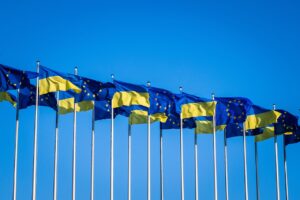
Electricity imports on January 21 will amount to almost 7 thou MWh – it is 290-291 MWh every hour, according to data on the website of the Continental Europe System Operators Network ENTSO-E.
According to the information, the electricity is supplied from Slovakia.
As reported on January 21, the interstate section of 290MW for every hour of the day was booked by “D.Trading”, 5MW for all hours of “ERU Trading”, as well as 1MW for three hours from 16:00 to 19:00″ August.
For Jan. 22, D. Trading and ERU Trading booked the same capacity plus 1 MW each for the two nightly hours of NAP Community.
A total of 300-350 MW was auctioned, depending on the hour of the day, with a buyout price of 0 UAH/MWh.
According to DaM Europe in the established JSC “Market Operator” Telegram channel, the average price for electricity on the Slovak Republic on January 21 – 130.83 EUR / MWh, in Ukraine, the price of electricity BASE period on the DAM – 83.71 EUR / MWh.
The import supply on January 21 is the third in January reflected on the ENTSO-E website. The first was on January 15 – a total of 655 MWh: three hours of 50 MW (from 02:00 – 05:00), the following hours of 125 MW, 170 MW and 150 MW, and from 21:00-22:00 another 20 MW. D. Trading (130 MW each for all hours), ERU Trading (20 MW each for all hours), and Nextrade (20-30 MW depending on the hour) booked the section for that day. The second was for January 20, 220 MW in the last hour of the day, the cross-section for which was bought by D.Trading.
The Cabinet of Ministers of Ukraine in early January approved a regulation on the peculiarities of electricity imports during the autumn-winter period of 2022/2023, which as an incentive for businesses to import more expensive European resource gave guarantees of non-disconnection on the volume of imported electricity. According to Energy Minister Herman Galushchenko at a briefing on 20 January, in order to receive guarantees of non-disconnection, businesses must import a significant amount of electric power in accordance with their consumption, indicating that “it cannot be 1 MW”.

The ongoing decrease in physical flows of Russian natural gas through Ukraine and Turkey in January 2023 indicates that traders no longer see the risks of Europe passing this winter, the former head of the Ukrainian GTS Operator Serhiy Makohon said.
He wrote about it on his page in Facebook.
Application for transit of Russian gas through the Ukrainian GTS on January 19 reduced by 25% (8.2 million cubic meters) compared to January 18 – up to 24.4 million cubic meters, including in Europe goes 19 million cubic meters, the rest – to Moldova, said Makogon.
“This shows that Western traders do not see the risks of passing this winter, so they are not willing to import gas at any price. And when gas prices on stock exchanges fell to $600 per thousand cubic meters, traders refused to order additional volumes under existing long-term contracts with Gazprom in favor of purchase on the exchange,” explained the former head of UGTSU.
“And the Freeport LNG terminal, which is responsible for 20% of U.S. LNG exports and has been under repair since June, will also start working very soon. Therefore, Gazprom’s profits will clearly be unenviable. The russian energy blackmail did not pass,” he added.
As reported, since June 2022, the transit of Russian gas through Ukrainian GTS was about 42 million cubic meters, from January-2023 it began to gradually decline against the background of warm weather, high levels of stocks in the EU UGS and declined to a 16-month low stock prices in Europe.

On Friday, 12 bulk carriers with corn, wheat, soybeans and sunflower meal left Ukrainian ports, the Joint Coordination Center (JCC) reports.
“On January 13, twelve vessels left Ukrainian ports, they are transporting a total of 346,356 tonnes of grain and other food within the framework of the Black Sea grain initiative,” the report says.
Two bulk carriers Cuma (70,799 tonnes of corn) and Georgia T (61,252 tonnes of sunflower meal) are heading to China, two vessels Solar (37,205 tonnes of wheat) and Bosphorus King (25,000 tonnes of corn) are heading to Italy. Two more bulk carriers Rio (8,500 tonnes of wheat) and Umit G (4,300 tonnes of wheat) headed for Greece.
The vessel Papua will deliver 29,300 tonnes of soybeans to the Netherlands, the vessel Cape Scott – 28,000 tonnes of corn to Portugal, the vessel New Faith – 26,500 tonnes of corn to Spain.
In addition, two vessels Garnet (33,000 tonnes of corn) and Muzaffer Ana (11,500 tonnes of soybeans) went to Turkey. Lady Hatice will ship 11,000 tonnes of sunflower meal to Morocco.
Five vessels are also being sent to the ports of Ukraine, which passed through the humanitarian corridor on Friday.
The JCC reported that “79 applications for participation in the initiative were submitted.” Ten vessels are awaiting permission to enter the ports of Ukraine, 14 loaded vessels are awaiting departure to their destinations.
“As of January 13, the total tonnage of grain and other agricultural products exported from three Ukrainian ports is 17.3 million tonnes. A total of 1,286 vessels have been allowed to move at the moment: 639 to arrive at Ukrainian ports and 647 to exit them,” the JCC summed up.

Ports of “Big Odessa” last Saturday and Sunday dispatched 390 thousand tons of agricultural products within the framework of the “Grain Initiative”, the Ministry of Infrastructure of Ukraine reported.
“For the last two days, nine ships left the ports of “Big Odessa” to deliver 390 thousand tons of agricultural products to Africa, Asia and Europe, including bulk carriers ALANDA STAR and SSI PRIVILEGE with 68 thousand tons of wheat for Egypt and Indonesia, as well as tanker EUROCHAMPION with 45 thousand tons of vegetable oil for India,” the Ministry noted.
The Ministry notes that 24 ships are being processed at the ports, involved in the “grain initiative. They load more than 860 thousand tons of Ukrainian agricultural products.
“Grain corridor” also moves three vessels for the loading of 93 thousand tons of agricultural products.
At the same time, 99 ships are waiting for inspection in the Bosporus, 72 of which – to enter the ports for loading, 27 – already with Ukrainian agricultural products.
“Russia’s goal is to slow down the process of vessel inspections. First they reduced the number of inspection teams to three, now they started to drag out the time of inspections themselves. Representatives of the Russian Federation have started to check even indicators that are not stipulated in the documents of the SKC and have nothing to do with the subject of the inspection (for example, whether judicial units work well, how much fuel, etc.),” explains Deputy Minister of Community, Territory and Infrastructure Development Yuriy Vaskov.
According to him, under this algorithm, the inspection of a single ship takes four hours, which leads to a longer queue and at the same time a million losses for the cargo owners because of downtime.
According to the Ministry of Infrastructure, as of December 25, inspection group #3 had not held a single inspection, resulting in only six inspections per day out of 10 scheduled.
The agency noted that for continuous movement of grain corridor should be held at least 12 inspections per day.
In total, since August 1, 594 ships left the ports of Greater Odessa, which exported 15.5 million tons of Ukrainian food to Asia, Europe and Africa.

Three bulkers loaded with corn, wheat and vegetable oil departed from Ukrainian ports on Sunday, the Joint Coordination Centre (JCC) said.
“The Joint Coordination Centre (JCC) reports that three vessels left Ukrainian ports today [December 18], carrying a total of 54,464 tonnes of grain and other food products under the Black Sea Grain Initiative,” the JCC said.
MV Lady Ayana (25,250 tonnes of corn) and MV Barbaros Hayrettin V (5,214 tonnes of vegetable oil) are destined for Italy. MV AK Halima is transporting 11,100 tonnes of wheat and 11,900 tonnes of corn to Spain.
“Grains that reach a destination may go through processing and be trans-shipped to other countries,” the JCC said.
Five ships, which transited the maritime humanitarian corridor on Sunday, are headed to Ukrainian ports.
“As of 18 December, the total tonnage of grain and other foodstuffs exported from the three Ukrainian ports is 14,194,211 tonnes. A total of 1,128 voyages (565 inbound and 563 outbound) have been enabled so far,” the JCC said.

The European Commission (EC) approved on Tuesday the Horizon Europe work program for 2023-2024 to allocate about 13.5 billion euros to support researchers and innovators in Europe.
It is about finding “breakthrough solutions to environmental, energy, digital and geopolitical problems.”
“As part of the broader €95.5 billion EU Horizon Europe research and innovation program, funding for 2023-2024 will support the EU in achieving its climate goals, building resilience and developing basic digital technologies,” the European Commission said in a communiqué published in Brussels.
The document said it would also “consider targeted actions to support Ukraine, build economic resilience and promote sustainable recovery from the COVID-19 pandemic.”
Brussels explained that the targeted assistance to Ukraine is in addition to the 70 million euros earmarked for special measures already initiated in 2022. The additional support foresees the enhancement of access of Ukrainian scientists to European research infrastructures, continuation of the assistance to Ukrainian medical scientists, assistance in the struggle against climate change and assistance in reconstruction of several Ukrainian cities with the participation of the EU mission on climate-neutral and “smart” cities.
The EC communiqué also notes that over 42% of the 2023-2024 work program budget, or €5.67 billion, is earmarked for climate change and digital transformation projects. Some 970 million euros will be invested “to accelerate the transition to clean energy in line with the European REPowerEU plan and increase Europe’s energy independence.